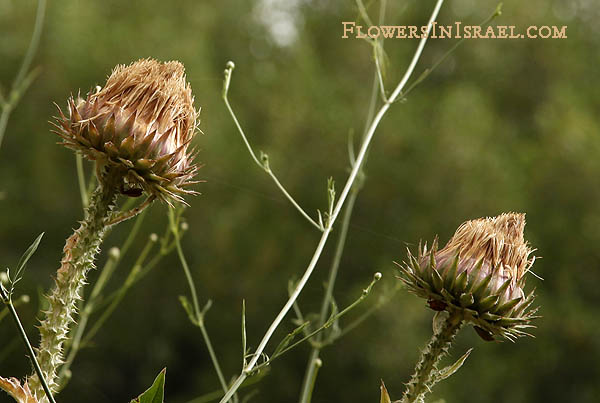Hebrew: ,חוחן בלאנש, Arabic: شوك
| Scientific name: | Onopordum blancheanum (Eig) Danin | |
| Synonym name: | Onopordum carduiforme subsp. blancheanum Eig | |
| Common name: | Cottonthistle | |
| Hebrew name: | חוחן בלאנש | |
| Arabic name: | شوك | |
| Family: | Compositae / Asteraceae, מורכבים |

|
| Life form: | Henicryptophyte | |
| Spinescence: | Leaves, bracts | |
| Branching: | 2-10cm above the ground | |
| Leaves: | alternate, rosette, entire, dentate or serrate | |
| Flowers: | Length of peduncles: 20-50 cm; Color of corolla: dark purple; head diameter: 30-55 mm | |
| Flowering Period: | March, April, May, June | |
| Habitat: | Batha, Phrygana, nests of harvesting ants and synanthropic disturbed habitats | |
| Distribution: | eastern Upper Galilee, Golan | |
| Altitude: | 350-1000 above sea level | |
| Chorotype: | Mediterranean | |
| Summer shedding: | Ephemeral |

Derivation of the botanical name: Onopordum, an early Latin name for a group of thistles, derived from the Greek onos, meaning "ass", and porde, flatulence, because of the belief that the plant caused flatulence in donkeys. blancheanum, named for Charles Isidore Blanche (1823 - 1887), a French plant collector in Tanger (1850 - 1851), subsequently consul at Tripoli and Beirut, also collecting plants in Syria. The Hebrew name: חוחן, khokhan, derivated from חוח, khokh, briar, thorn; related to Aramaic: חוחא, Akkadian: hàh ( = thorn), hahhu, hàyahu ( = thorn).
Onopordum blancheanum (Eig) Danin prefers basalt soils at an altitude of 300-1000 m and differs by its habitus and flower color from the Onopordum carduiforme Boiss. that is confined to the sandy soils of the coastal plain of Israel. 

|